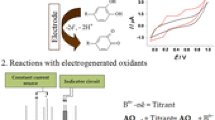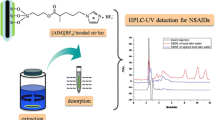Abstract
An autographic assay suitable for the detection of antioxidant compounds in a complex matrix (liquid and semi-solid pharmaceutical formulations) or in isolated compounds was described. The pre-formed radical monocation of 2,2′-azinobis-(3-ethylbenzothiazoline-6-sulfonic acid) (ABTS•+) was generated by oxidation of ABTS with potassium persulfate and reduced in the presence of hydrogen-donating antioxidants. For a further comparative estimation of its applicability and sensitivity, different medicinal plant extracts, hydrogels and antioxidant compounds were dot seeded or chromatographed on silica gel (TLC) and revealed with ABTS•+ solution (System I) or ABTS•+ immobilized by gel entrapment (System II). Both systems were effective and able to detect antioxidant activity in a micromolar range in seconds. System II was more sensitive and reproducible than System I. This micromethod is quick, inexpensive, and particularly helpful whether it works with numerous samples or on a small scale.



Similar content being viewed by others
References
Cai Y, Luo Q, Corke H. Antioxidant activity and phenolic compounds of 112 traditional Chinese medicinal plants associated with anticancer. Life Sci. 2004;74:2157–84.
Ivanova D, Gerova D, Chervenkov T, Yankova T. Polyphenols and antioxidant capacity of Bulgarian medicinal plants. J Ethnopharmacol. 2005;96:145–50.
Yamaguchi T, Takamura H, Matoba T, Terao Y. HPLC method for evaluation of the free radical-scavenging activity of food by using 1, 1-diphenyl,-2-picrylhydrazil. Biosci Biotech Biochem. 1998;62:1201–4.
Re R, Pellegrini N, Proteggente A, Pannala A, Yang M, Rice-Evans C. Antioxidant activity applying an improved ABTS radical cation decoloration assay. Free Radic Biol Med. 1999;26:1231–7.
Rice-Evans CA. Measurement of total antioxidant as a marker of antioxidant status in vivo: procedures and limitations. Free Radic Res. 2000;33:S59–66.
Valentaõ P, Fernandes E, Carvalho F, Andrade P, Seabra R, Bastos M. Antioxidative properties of cardoon (Cynara cardunculus L.) infusion against superoxide radical, hydroxyl radical and hypochlorous acid. J Agric Food Chem. 2002;50:4989–93.
Singh N, Rajini P. Free radical scavenging activity of an aqueous extract of an aqueous extract of potato peel. Food Chem. 2004;85:611–6.
Ordoñez AA, Gomez D, Vattuone MA, Isla MI. Antioxidant activity of Secchium edule (Jacq) Swartz. Food Chem. 2006;97:452–8.
Zampini IC, Meson Gana J, Ordoñez RM, Sayago JE, Nieva Moreno MI, Isla MI. Antioxidant and xanthine oxidase inhibitory activities of plant species from the Argentine Puna (Antofagasta, Catamarca). Recent Progress in Medicinal Plants 2008;11:56–7. Studium, Houston
Johnston J, Dussert S, Gale S, Nadarajan J, Harding K, Benson EE. Optimisation of the azinobis-3-ethyl-benzothiazoline-6-sulphonic acid radical scavenging assay for physiological studies of total antioxidant activity in woody plant germplasm. Plant Physiol Biochem. 2006;44:193–201.
Nieva Moreno MI, Isla MI, Cudmani NG, Vattuone MA, Sampietro AR. Screening of antibacterial activity of Amaicha del Valle (Tucumán-Argentina) propolis. J Ethnopharmacol. 1999;68:97–102.
Zampini IC, Vattuone MA, Isla MI. Antibacterial activity of Zuccagnia punctata Cav. ethanolic extracts. J Ethnopharmacol. 2005;102:450–6.
Sawaya AC, Palma AM, Caetano FM, Marcucci MC, Cunha IB, Araujo CE, et al. Comparative study of in vitro methods used to analyse the activity of propolis extracts with different compositions against species of Candida. Lett Appl Microbiol. 2002;35:205–7.
Ramallo A, Zacchino S, Furlan R. A rapid TLC autographic method for the detection of xanthine oxidase inhibitors and superoxide scavengers. Phytochem Anal. 2006;15–9
Juma FB, Majinda RR. Erythrinaline alkaloids from the flowers and pods of Erythrina lysistemon and their DPPH radical scavenging properties. Phytochemistry. 2004;65:1397–404.
Soler-Rivas C, Espin J, Wichers H. An easy and fast test to compare total free radical scavenger capacity of foodstuffs. Phytochem Anal. 2000;11:330–8.
Ordóñez A, Ordóñez RM, Zampini IC, Isla MI. Design and quality control of a pharmaceutical formulations containing natural products with antibacterial, antifungal and antioxidant properties. Int J Pharm. 2009;378:51–8.
Singleton V, Orthofer R, Lamuela-Raventos R. Analysis of total phenols and other oxidation substrates and antioxidants by means of Folin Ciocalteu reagent. Methods Enzymol. 1999;299:152–78.
Wagner H, Bladt S, Zgainsky E. Plant drug analysis: a thin layer chromatography. Berlin: Springer; 1984.
Miller N, Rice-Evans C, Davies M, Gopinathan V, Milner A. A novel method to measuring antioxidant capacity and its application to monitoring the antioxidant status in premature neonates. Clin Sci. 1993;84:407–12.
Miller N, Sampson J, Candeias L, Bramley P, Rice-Evans C. Antioxidant activities of carotenes and xanthophylls. FEBS Lett. 1996;384:240–2.
Rice-Evans C, Miller N, Paganga G. Structure-antioxidant activity relationship of flavonoids and phenolic acids. Free Radic Biol Med. 1996;20:933–66.
Wang H, Cao G, Prior R. Total antioxidant capacity of fruits. J Agric Food Chem. 1996;44:701–6.
Schleiser K, Harwat M, Bohm V, Bitsch R. Assessment of antioxidant activity using different in vitro methods. Free Radic Res. 2002;36:177–87.
Labrinea EP, Georgiou CA. Stopped-flow method for assessment of pH and timing effect on the ABTS total antioxidant capacity assay. Anal Chim Acta. 2004;526:63–8.
Ozgen M, Neil Reese R, Tulio J, Scheerens K, Miller A. Modified 2,2-Azino-bis-3-ethylbenzothiazoline-6-sulfonic acid (ABTS) method to measure antioxidant capacity of selected small fruits and comparison to ferric reducing antioxidant power (FRAP) and 2,2-diphenyl-1-picrylhydrazyl (DPPH) methods. J Agric Food Chem. 2006;54:1151–7.
Acknowledgments
This research was supported by grants from Consejo de Investigación de la Universidad Nacional de Tucumán, Argentina (CIUNT), Consejo Nacional de Investigaciones Cientificas y Tecnicas (CONICET), and Agencia Nacional de Promoción Científica y Tecnológica (ANPCyT).
Author information
Authors and Affiliations
Corresponding author
Rights and permissions
About this article
Cite this article
Zampini, I.C., Ordoñez, R.M. & Isla, M.I. Autographic Assay for the Rapid Detection of Antioxidant Capacity of Liquid and Semi-solid Pharmaceutical Formulations Using ABTS•+ Immobilized by Gel Entrapment. AAPS PharmSciTech 11, 1159–1163 (2010). https://doi.org/10.1208/s12249-010-9484-y
Received:
Accepted:
Published:
Issue Date:
DOI: https://doi.org/10.1208/s12249-010-9484-y




